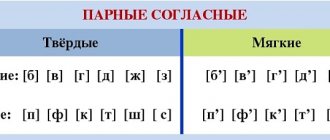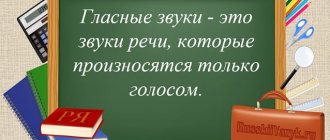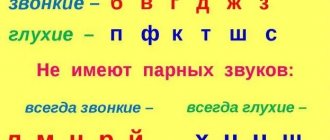Tales about sounds for children
Educational fairy tales for children
In the Land of Sounds
Lived in a magical land of sounds. This country was very tiny. And there were only 31 inhabitants. No one saw them, since they were invisible. But you could hear them. Six sounds were singers: A, U, Y, I, E, O. They were called vowels for their melodiousness and vocality. Ya, Yo, Yu, E sang along with them. The remaining 21 were also kind, with good sounds, but they could not sing. Listen: B, V, G, D, F, Z, J, K, L, M, N, P, R, S, T, F, X, C, Ch, Sh, Shch. They were very friendly, agreed with the vowels in everything, loved to stand next to them. And they were called consonants. You can also sing along with them, but to do this you need to be able to recognize all the sounds and pronounce them correctly.
“How sounds learned to turn into letters”
A lot of time has passed since sounds settled in one magical land. They were invisible, but they loved to sing. One day, a wizard from another kingdom appeared in that country. He liked it there so much that he wanted to get to know its inhabitants better. And when he found out that all the residents were invisible, he was very upset. But he was still a wizard, and a very kind one at that. And he decided to give each resident a magic dress. Each sound received a dress unlike the others. As soon as you put it on, the sound immediately became visible and turned into a letter. The letter could be seen, depicted, drawn, written. The wizard was very pleased. After all, now, having read or sung it, or whispered it, he called the sound by name. That's how they met.
Always together
One day the vowels and consonants did not get along and went in different directions. The consonants huddled together, wanted to talk - but nothing... They coughed: - Kh! They sneezed: Pchh! For some reason they called the cat: -Ks, ks, ks! And we got bored... Suddenly: -Shh! It seemed to them that someone was crying somewhere... They listened. -Ah-ah-ah! Oh-oh-oh! - shouted the vowels. They cried like little children: -Wow! Wow! Aukali: -Aw! Aw! And the consonants shouted to them (or rather, they wanted to shout, but they only managed to mumble): - BDM VSGD VMST! And they heard a joyful, but also indistinct: -U-E-E-A-E-E! They made peace, stood next to each other again, and said clearly: - WE WILL ALWAYS BE TOGETHER! And since then they have never been separated again.
Parade of letters
When two brothers b and b settled in the magical land of Alphabet Studies, there were exactly 33 inhabitants. Each had their own home, but could not exchange it for another. There were such strict laws there. One day, the Alphabet and Queen ABC decided to throw a party. All sounds put on dresses, turned into letters and went to the main square. The king gave the command to the letters to line up and take each one in its place, according to the number of the dwelling. This is the order in which the letters were: A, B, C, D, D, E, E, G, Z, I, Y, K, L, M, N, O, P, R, S, T, U, F, X, Ts, Ch, Sh, Sh, b, Y, b, E, Yu, Ya. Queen ABC really liked the structure of the letters. Since then, the structure of letters in this order began to be called by the name of the king - ALPHABET or the queen - ABC. Anyone who wants to know the secrets of this magnificent country must, like a king, know the order of the letters by heart.
Accent
One day they gathered together for council and began to say how useful and significant they all were. But they forgot to invite the words to their council STRESS. And it was very offended. When the words began to emerge, the accent suddenly jumped out and shouted: “What do you know without me?” If I want, I’ll take it and change the values for you! Of course, they didn’t believe the words. The castle came out and said: “I’m not afraid of you, I’m so strong and heavy that I can handle some kind of IMPACT.” After all, Accent is just a dash! The stress got angry and suddenly jumped from the last syllable to the first, and the castle disappeared, and a castle appeared. The words began to be indignant, to shame the Accent, but it continued to prove its importance. So instead of Atlas it turned out to be Atlas, instead of drops-drops, instead of road-road. They see words that things are bad - they cannot do without Emphasis! They gave him a place of honor at their meeting and since then they have treated the Accent with great respect.
We recommend watching:
Mathematical fairy tales for schoolchildren Psychological fairy tales for children How to read fairy tales to children correctly Old fairy tale in a new way “Turnip” (using proverbs and sayings)
Similar articles:
Fairy tales for children. Fox-sister and gray wolf
Fairy tales for primary schoolchildren. Warm bread
Ivan - peasant son and miracle Yudo
Nesmeyana the princess. Fairy tale
Marya Morevna. Fairy tale. Read
Fairy tales about vowels and consonants
Elena Evdokimova
Fairy tales about vowels and consonants
In order to help children learn the concepts of “ Vowels and consonants fairy tales and the “house of sounds in my work .
I begin work on introducing children to vowels , then to consonant sounds . As I get acquainted with a new sound , I simultaneously introduce the graphic image of the letter.
Fairy tales about vowels and consonants
A Tale of Vowel Sounds
In one magical country there lived sounds , this country was very tiny. No one had ever seen the inhabitants of this country, since they were invisible, but they could be heard. Six sounds were singers : A, U, O, I, E, Y. For their melodiousness and vocality they were nicknamed vowels . They were very friendly. These sounds sang magical songs. We can also sing along with them, but to do this we need to recognize all the sounds and pronounce them correctly.
To reinforce the concept of “ vowel sounds ”
You can give the child a red circle, symbolizing
“
vowel sounds ” A, U, O, I, E, Y.
The vowels stretch out in a ringing song
They may cry and scream.
They can cradle a child in a crib,
But they don’t want to whistle and grumble.
Air flows freely through the mouth,
There are no different obstacles. The voice is involved, the voice is calling. The sound is vowel .
A Tale of Consonants
“Listen to “ The Tale of Consonants ”
».
“Once upon a time there were cheerful sound men . They knew how to sing songs. Their names were "A"
,
“O”
,
“E”
,
“U”
,
“Y”
,
“I”
, and together they were called “
vowel ” sounds . The vowel sounds had ringing voices and they sang like birds. One day they sang so joyfully that other sounds wanted to sing like that . “P-P-P” - the consonant sound “P” puffed.
He puffed and puffed, but couldn’t sing the song. He cried and began to burn: “Oh, how unsinging I am, I don’t have a voice, I can’t sing.” “T-T-T” - the sound “T” knocked, Knocked, knocked, but could not sing the song. He cried, he began to sunbathe; “Oh, how unlucky I am, I also have no voice, almost no one hears me.”
“K-K-K” - the sound “K” groaned and also could not sing the song.
“Don’t be sad, not melodious sounds ,” said the vociferous girl - the sound “A”, “We, vowel sounds , can help everyone. Only you must always stand next to us. Do you agree ? “ We agree ! We agree !” - the sounds .
Since then, vowels and consonants . They will stand next to you and sing any song. You can sing a song with your children to the melody of a familiar song.
Didactic game for teaching literacy “Vowel sounds and letters” Purpose: to promote the development of sound-letter analysis; development of phonemic hearing. Strengthen knowledge of vowel sounds and letters; learn.
Didactic game for speech development “Vowels and Consonants” The didactic game is intended for children from 5 to 7 years old. Goal: to teach children to divide letters into vowels and consonants, to form syllables from them.
Summary of educational activities for preparing for teaching literacy in the preparatory group “Vowel sounds and letters” Purpose: to summarize the knowledge of preschoolers about the studied vowel sounds and letters (a, o, u, i, s). Objectives: Developmental: • Develop phonemic awareness.
Summary of educational activities for speech development “Vowel sounds” Integration of educational areas: “Speech development”, “Social and communicative development”, “Physical development”, “Cognitive development”.
Summary of a lesson on teaching literacy in the preparatory group “Vowels and sounds” Summary of a lesson in the preparatory group on literacy Topic: “Vowels and sounds” The lesson was prepared and conducted by a GBOU teacher.
Lesson summary “Consonant sounds [N], [N'], letters N, n” Topic: Consonant sounds (n, n, letters N, n. Purpose: • to introduce the sounds (n, n) and letters N, n; give an idea of what one letter can do.
Poems on vowel sounds. A poem dedicated to the anniversary of the preschool educational institution In the morning the duck flew away, smiled and sang. The street was surprised: Our duck is smart! In autumn the cloud turned gray, Donkey looked at the sad.
Summary of the literacy lesson “Sounds. Speech and non-speech sounds. Vowels, consonants” Purpose: formation of the concepts of “sound”, “consonant sound”, “vowel sound”. Objectives: • To form the concept of “sound”. • Children's phonemic awareness.
Source
How to teach a child to read? How to master writing and reading without tears? Many parents ask such questions, are interested in good aids for teaching reading and writing, and try to unobtrusively instill in their child the joy of interacting with books. It’s great that we live in the modern world, where learning to read is possible through a game format, interesting tasks and fascinating fairy tales! This collection contains books about letters and sounds that will help your child remember the correct spelling of simple words, learn how to pronounce complex sounds correctly, understand how important it is to write accurately, and simply plunge into the world of fun word games.
Volt Suslov “Difficult letters”
A collection of funny poems for pronouncing complex sounds - whistling, hissing, growling and ringing. The author managed to rhyme many words with the most difficult sounds to pronounce - zh, l, x, sh, sch, z, s. At the same time, the poems have meaning, a small plot, and sometimes even humor. One spread – one poem using a specific letter. The illustration not only depicts what the poem describes, it is also a verbal game for the child, because there are many objects drawn in which a certain sound is present. Moreover, it can be located either at the beginning, in the middle or at the end - try to find it. The volume of the book is small, only 24 pages. It is best to use with children aged 4-5 years, as many words may not be clear to younger children.
Oksana Stasi “The Country of Unreading”
In one fairy-tale city, a little boy from a family of sorcerers did not want to attend the school of Wizards and did not like to study at all, but since he knew a little magic, he bewitched the city, and now all the inhabitants forgot how to read, the books disappeared, and the letters scattered. It’s good that one boy’s grandmother told fairy tales and even remembered some letters, so he understood the importance of reading. The boy gathered a team of friends who also wanted to learn to read, and went in search of letters. In this book, teaching a child to read is woven into a good fairy tale. One by one, children find different letters and, having written a poem about each of them, get the letters in a special notebook. Thus, in a playful way, together with the characters of the book, you can find letters, combine them into syllables and learn to read. Some pages have encyclopedic inserts explaining complex words. The set includes an audio CD and a reading book. 152 pages, hardcover. For children from 4 years old.
Andrey Usachev “ABC for Buki”
One day, an alien appeared in the most ordinary apartment. The girl Anya met him, and she taught As Buku to read and pronounce our words. A fascinating plot, light humor, a funny play on words - the alien was a diligent student and if he asked again, it was only on the matter. But for us earthlings his questions are very funny and amusing. At the end of the book there is a Buko-Russian dictionary; it is interesting to read, comparing it with the generally accepted meanings of Russian words. There are so many funny words: mumuks and memeks - cows and goats, baobabniks - beeches living on baobabs, oranges - blue, and the most delicious - apelkras. There is no need to introduce Andrei Usachev, this is already a modern classic for children. Light style, humor, funny characters - these are the distinctive features of his books. Hardcover, 176 pages. Each spread has color illustrations. The book will appeal to children aged 5 years and older.
Alexander Lugarev “Bookvograd. Fun games and tricky puzzles" (Pythagorean Pants series)
The book, which can rather be called a workbook, will help consolidate the ability to read and write. On each page there are tasks for turning one word from another, finding the right page, filling out captions for pictures, selecting the right words for an illustration, etc. There are riddles, puzzles, crosswords. Moreover, to complete some tasks you need not only knowledge of letters, but also various fairy tales and concepts of the surrounding world. The big advantage of the book is that there are only 1-2 tasks per page, which helps the child not to wander. A publication for those who already know how to read and write and only need to consolidate these skills, that is, for children from 6 years old. At the end of the book there are answers to the tasks. The Pythagorean Pants series has published many educational books, most of which are reprints of recognized classics of scientific thought. 64 pages, softcover.
Mikhail Raskatov “The Missing Letter”
Many of us remember this book from the good old Soviet childhood. About how two lazy brothers ended up in Bukvograd and saved Sh from KrivPoch. The boys have made a serious journey from poor students to diligent students, and we, the readers, learn with them how important every letter and every hook is when writing. I am glad that penmanship and correct pronunciation are presented in the form of a fascinating fairy tale. Agree, this is much more interesting than in the form of strict rules. The tale is written in easy language, instructive, but without intrusiveness. In addition to reading, the book teaches courage, honesty, friendship and mutual assistance. There is a map on which the movements of the heroes could be traced. The book is slightly larger than A5 format, convenient to take with you. 120 pages. Thick paper, large font. For children from 6 years old.
Mikhail Yasnov “Feast of the Primer”
The book of poems by the famous children's poet is intended, rather, not for learning letters, but for reading. M - ant, a - pansy, w - noisy forest. The poems are dedicated to many letters, but there are also poems about school, about studying and just playing with words. Brisk rhymes, funny images - Mikhail Yasnov’s poems are easy to remember. They can be taught for the holiday at school or kindergarten. Large font, color illustrations. For children from 5 years old.
Andrey Usachev “Malusya and Rogoped”
A tale of good and evil. Or not, about letters and sounds. Or is it about both? The story itself is about a girl, Marusya, who finds herself in an unusual country and there various encounters and adventures happen to her. The fairy tale is somewhat reminiscent of “The Wizard of the Emerald City,” but still different. An interesting story about how 1-2 letters changed in a word (which is so common for small children with undeveloped speech to pronounce) radically change the words and their meaning. The book helps the child, having understood the essence of the fairy tale, try to pronounce the words more clearly and correctly. Vibrant illustrations, hard cover, 144 pages.
Sinyavsky P., Usachev A., Yasnov M. “Naughty letters. Speech therapy poems and difficult words"
Funny poems that use wordplay can help a child just as well as a speech therapist. Here complex sounds Z, R, Zh, Sh, F and others are worked out. The masters of poetry have done a good job with the Russian language - the poems are not only useful, but also funny, so they are easy to remember, and they are also interesting to read. The volume of the book is not very large, 64 pages, but this is enough for a good nightly verbal training. Colorful illustrations vividly complement the mischievous plot. Thick pages, large format, hard cover. Suitable for children aged 4–5 years.
Elena Ulyeva “A primer in fairy tales”
Children begin to be interested in letters quite early: from the age of 4–5, but this interest is rather out of curiosity. A child sees letters when his parents read books to him, he understands that this is something interesting and exciting, which means he needs to figure it out. Therefore, this story is suitable for such inquisitive children, in which you can travel around the country where letters live. Using early development pedagogy, the author gradually immerses the child in the world of letters in such a way that there is visual, sound and semantic perception (with the help of associations, the memorization process occurs better). There are practical tasks on composing and reading syllables and words. In addition, the book contains entertaining tasks to develop attention, imagination, logic and speech. Colorful illustrations, A4 format, hard cover.
Irina Tokmakova “Alya, Klyaksich and the letter “A””
This fairy tale is the perfect way to introduce your child to the alphabet. Children's perception works in such a way that it is not enough for a child to be shown letters in order for him to remember them; associations and emotions are needed. And there is plenty of this in the book! Plunging into incredible adventures with the girl Alya and the letter “A”, the child becomes a storyteller, a rescuer, and a discoverer. The author creates the effect of presence, and the child himself does not notice how he remembers the letters. Large font is convenient for independent reading. Vibrant illustrations, thick pages. This book is suitable not only for a child who cannot yet read and is becoming familiar with letters, but also for a child who already knows how to read, because who can resist adventure?
Marina Aromstam “A little dachshund, a little terrier named Robespierre. The use of the separator b" (from the series "Non-boring spelling lessons with Marina Aromshtam")
An interesting author’s technique for working out a soft sign. It is no secret that it is sometimes difficult for younger schoolchildren to learn this letter in writing, since they still need to hear it. A twisting plot with extensive background information, presented in a playful manner, with humor and fun tasks. Here you can develop your imagination, color the picture, but the most important thing is to remember through all this how and where the soft sign is written. All the books in this series may be interesting, in which important rules of the Russian language are explained with the help of materials that captivate you from the first pages.





